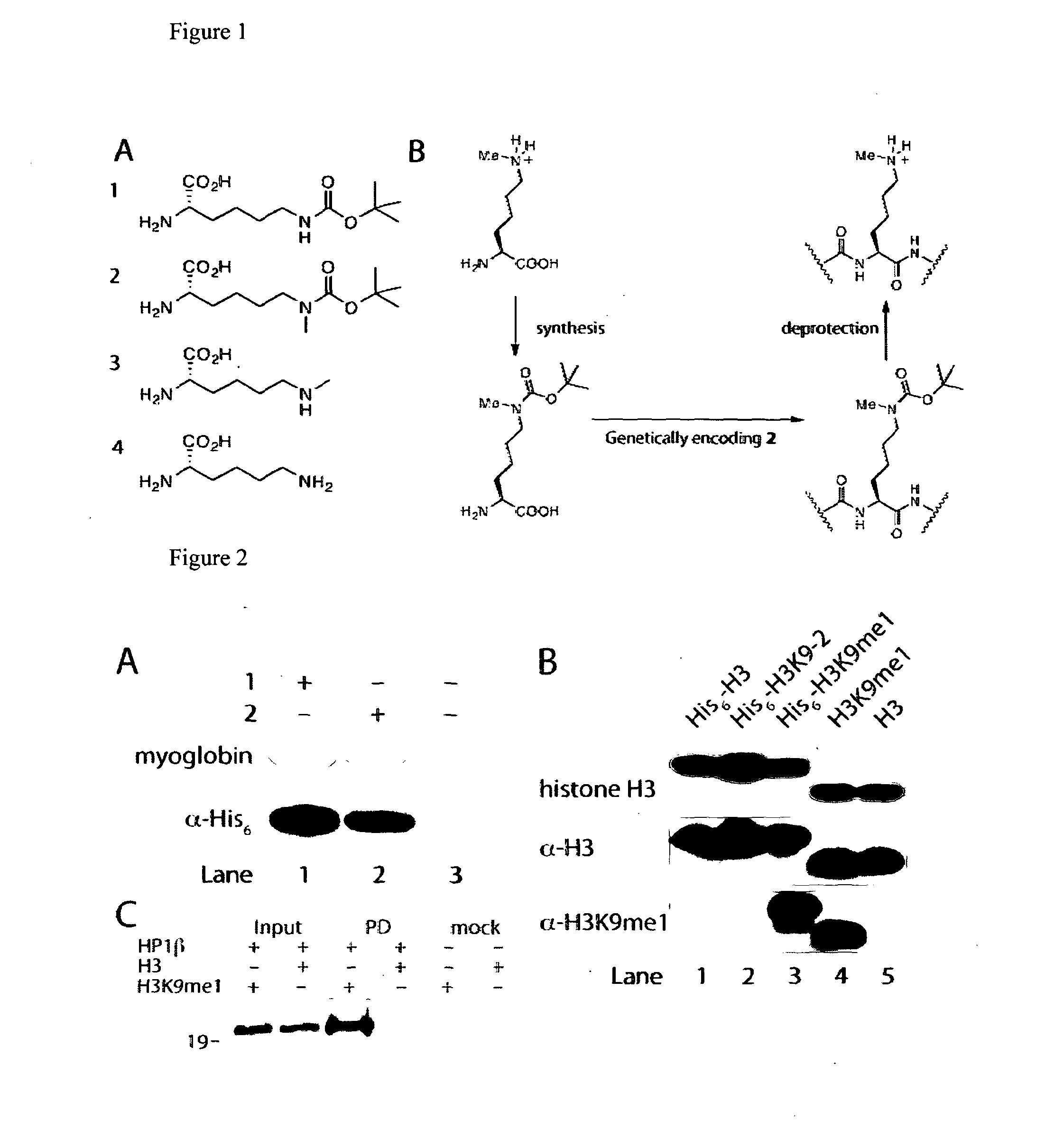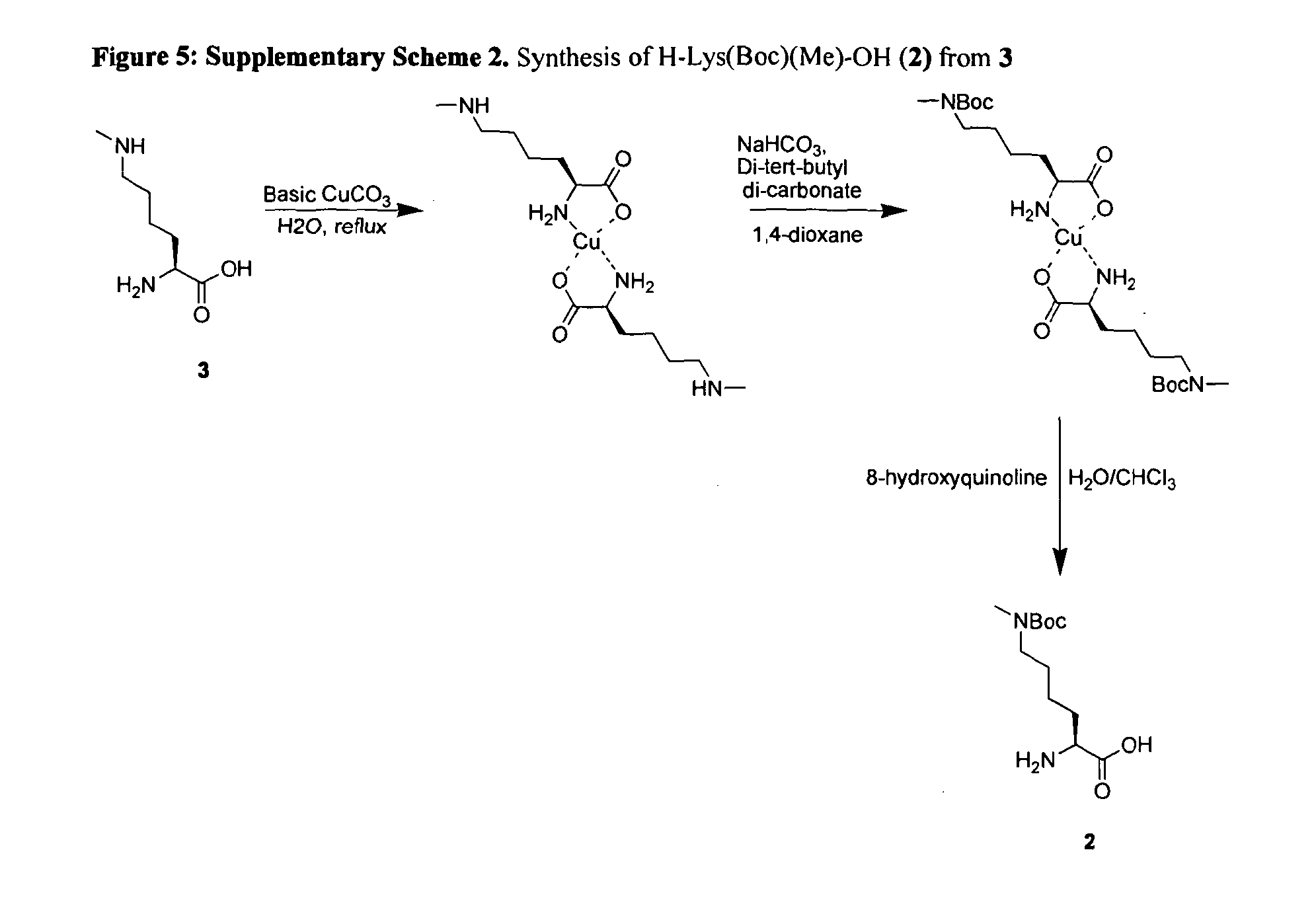Incorporation of methyl lysine into polypeptides
- Summary
- Abstract
- Description
- Claims
- Application Information
AI Technical Summary
Benefits of technology
Problems solved by technology
Method used
Image
Examples
example 1
Production of Polypeptide Comprising Nε-methyl-lysine
[0128]We realized that we might be able to encode Nε-methyl-L-lysine (3) indirectly by providing the synthetase enzyme with a substrate that was significantly different from both Nε-methyl-L-lysine and L-lysine if we were able to subsequently effect the facile, quantitative and specific post-translational conversion of this precursor to Nε-methyl-L-lysine on the synthesized protein. Since Nε-tert-butyl-oxycarbonyl-L-lysine (1) is an efficient substrate for the pyrrolysyl-tRNA synthetase / tRNACUA pair19 we asked whether Nε-methyl-L-lysine (3) could be incorporated into proteins in a two-step process in which Nε-tert-butyl-oxycarbonyl-Nε-methyl-L-lysine (2) is genetically incorporated into proteins and the tert-butyl-oxycarbonyl group is removed post-translationally to reveal Nε-methyl-L-lysine (see FIG. 1—Strategies for encoding lysine methylation. A. amino acids used B. Schemes for encoding 3 in recombinant proteins.)
[0129]To inves...
example 2
[0130]To demonstrate that 2 can be incorporated with high fidelity into recombinant proteins and is not subjected to in vivo modification14, we performed electrospray ionization mass spectrometry (ESI-MS) on the purified protein. The ESI-MS spectra of myoglobin-His6 demonstrates the quantitative incorporation of 2 (FIG. 7A). These data demonstrate that 2 can be genetically encoded in proteins in good yield and with high fidelity using MbPylRS / MbtRNACUA pair.
example 3
Application to Histones
[0131]To specifically and efficiently introduce 2 in a histone at physiologically relevant site, we transformed E. coli BL21(DE3) with pBKPylS and pCDF-PylT-H3K9TAG (a vector which encodes MbtRNACUA and a N-terminally hexahistidine tagged histone H3 gene in which the codon for lysine 9 is replaced with an amber codon)15. We grew the cells in the presence of 2 mM 2, and expressed and purified the recombinant histone in good yield (2 mg per liter of culture). ESI-MS analysis of the purified histone confirms the incorporation of 2 into histone H3 (FIG. 7B).
PUM
| Property | Measurement | Unit |
|---|---|---|
| Temperature | aaaaa | aaaaa |
| Fraction | aaaaa | aaaaa |
| Time | aaaaa | aaaaa |
Abstract
Description
Claims
Application Information
 Login to View More
Login to View More - R&D
- Intellectual Property
- Life Sciences
- Materials
- Tech Scout
- Unparalleled Data Quality
- Higher Quality Content
- 60% Fewer Hallucinations
Browse by: Latest US Patents, China's latest patents, Technical Efficacy Thesaurus, Application Domain, Technology Topic, Popular Technical Reports.
© 2025 PatSnap. All rights reserved.Legal|Privacy policy|Modern Slavery Act Transparency Statement|Sitemap|About US| Contact US: help@patsnap.com



